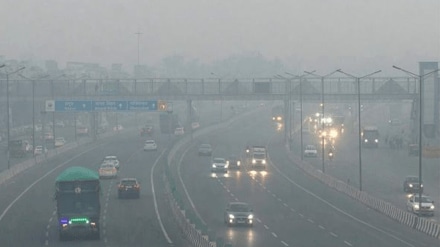Delhi AQI: The air quality in Delhi remained in the “very poor” category on Monday, with the AQI recorded at 345 at 8 am – a slight improvement from yesterday’s 391, which was recorded at 7 am. Most monitoring stations in the capital reported “very poor” air quality levels, though Bawana continued to register “severe” pollution, with an AQI of 412.
Central Pollution Control Board (CPCB) data from 8 am show that air quality across most parts of Delhi remained in the “very poor” category, with a few locations slipping into “severe” levels. Bawana recorded the highest AQI at 412, placing it in the “severe” range. Areas such as Anand Vihar (379), Burari Crossing (389), ITO (375), Nehru Nagar (387), and Rohini (390) reported “very poor” air quality. Stations including DTU (286), IHBAS Dilshad Garden (227), Lodhi Road (236), and NSIT Dwarka (218) registered slightly better readings in the “poor” category.
The pollution levels across the national capital continued to indicate hazardous conditions for residents, with only marginal variation between monitoring sites.
Delhi AQI at 8 am today
| Station | Index Value | Air Quality |
|---|---|---|
| Anand Vihar | 379 | Very Poor |
| Ashok Vihar | 361 | Very Poor |
| Aya Nagar | (insufficient data to compute AQI) | (insufficient data to compute AQI) |
| Bawana | 412 | Severe |
| Burari Crossing | 389 | Very Poor |
| CRRI Mathura Road | 365 | Very Poor |
| Chandni Chowk | 355 | Very Poor |
| DTU | 286 | Poor |
| Dr Karni Singh Shooting Range | 367 | Very Poor |
| Dwarka-Sector 8 | 358 | Very Poor |
| IGI Airport | 307 | Very Poor |
| IHBAS, Dilshad Garden | 227 | Poor |
| ITO | 375 | Very Poor |
| Jahangirpuri | 389 | Very Poor |
| JLN Stadium | 322 | Very Poor |
| Lodhi Road (IITM) | 236 | Poor |
| Lodhi Road (IMD) | 314 | Very Poor |
| Major Dhyan Chand National Stadium | 325 | Very Poor |
| Mandir Marg | 343 | Very Poor |
| Mundka | 377 | Very Poor |
| NSIT Dwarka | 218 | Poor |
| Najafgarh | 337 | Very Poor |
| Narela | 368 | Very Poor |
| Nehru Nagar | 387 | Very Poor |
| North Campus | 351 | Very Poor |
| Okhla Phase-2 | 348 | Very Poor |
| Patparganj | 376 | Very Poor |
| Punjabi Bagh | 324 | Very Poor |
| Pusa (DPCC) | 345 | Very Poor |
| Pusa (IMD) | 328 | Very Poor |
| R K Puram | 363 | Very Poor |
| Rohini | 390 | Very Poor |
| Shadipur | 327 | Very Poor |
| Sirifort | 357 | Very Poor |
| Sonia Vihar | 369 | Very Poor |
| Sri Aurobindo Marg | 314 | Very Poor |
| Vivek Vihar | 357 | Very Poor |
| Wazirpur | 397 | Very Poor |
As of 8 am today, cities with moderate air quality include Jaipur (197), Lucknow (119), Ahmedabad (150), Bengaluru (119), Chennai (115), Hyderabad (106), Mumbai (103), and Patna (178). Pune (86) recorded a satisfactory air quality level, according to CPCB data.
According to the CPCB’s air quality classification, an AQI score of 0-50 is categorised as good, 51-100 as satisfactory, 101-200 as moderate, 201-300 as poor, 301-400 as very poor, and 401-500 as severe.
Protest at India Gate and the blame game
After Delhi’s air quality touched the season’s peak of 391, residents gathered at India Gate on Sunday to protest against the city’s hazardous pollution levels and to demand urgent action from the authorities. They were holding placards that read “Smog se Azadi! [freedom from smog]” and “Breathing is killing me”. This comes after most monitoring stations across the national capital recorded AQI readings in the “severe” category.
Delhi Environment Minister Manjinder Sirsa blamed the previous AAP government for the capital’s deteriorating air quality, alleging that it had “poisoned” Delhi’s air and water. He added that the Rekha Gupta government is now “working on a war footing” to address the crisis.
“AAP has governed Delhi for ten years and poisoned its air and water, wasting money on gimmicks like the odd-even policy. In the last seven months under Rekha Gupta’s leadership, we’ve deployed smog guns in high-rises, used water sprinklers for dust mitigation, monitored construction, notified 8,000 industries to control emissions, and transitioned all buses to electric. We’re working on a war footing, but we cannot clear the air that AAP polluted in the last decade,” he added.
AAP ने 10 साल तक प्रदूषण की रोकथाम करने के लिए कोई काम नहीं किया, बस हवा में ज़हर फैलाने का काम किया। सिर्फ़ अपनी नाकामियों को राजनीति, प्रचार और प्रोपेगंडा से ढकने की कोशिश की।
— Manjinder Singh Sirsa (@mssirsa) November 9, 2025
माननीय मुख्यमंत्री श्रीमती @gupta_rekha जी की सरकार में दिल्ली में हो रहे अच्छे कामों से इन लोगों को… pic.twitter.com/STcl0bhCBI
What different AQI levels mean for your health
According to the CPCB, “Good” air quality poses minimal health risks and has little to no impact on the general population. When air quality is classified as “Satisfactory,” it may cause slight breathing discomfort to sensitive groups such as children, the elderly, and individuals with existing respiratory conditions.
A “Moderate” AQI level can lead to breathing issues among people with lung diseases, asthma, or heart ailments. As air quality deteriorates to the “Poor” category, prolonged exposure may cause discomfort for most individuals.
In the “Very Poor” range, long-term exposure can trigger respiratory problems even in otherwise healthy people. At the most critical stage, “Severe,” air pollution can impact healthy individuals and pose serious health risks to those with pre-existing medical conditions.
